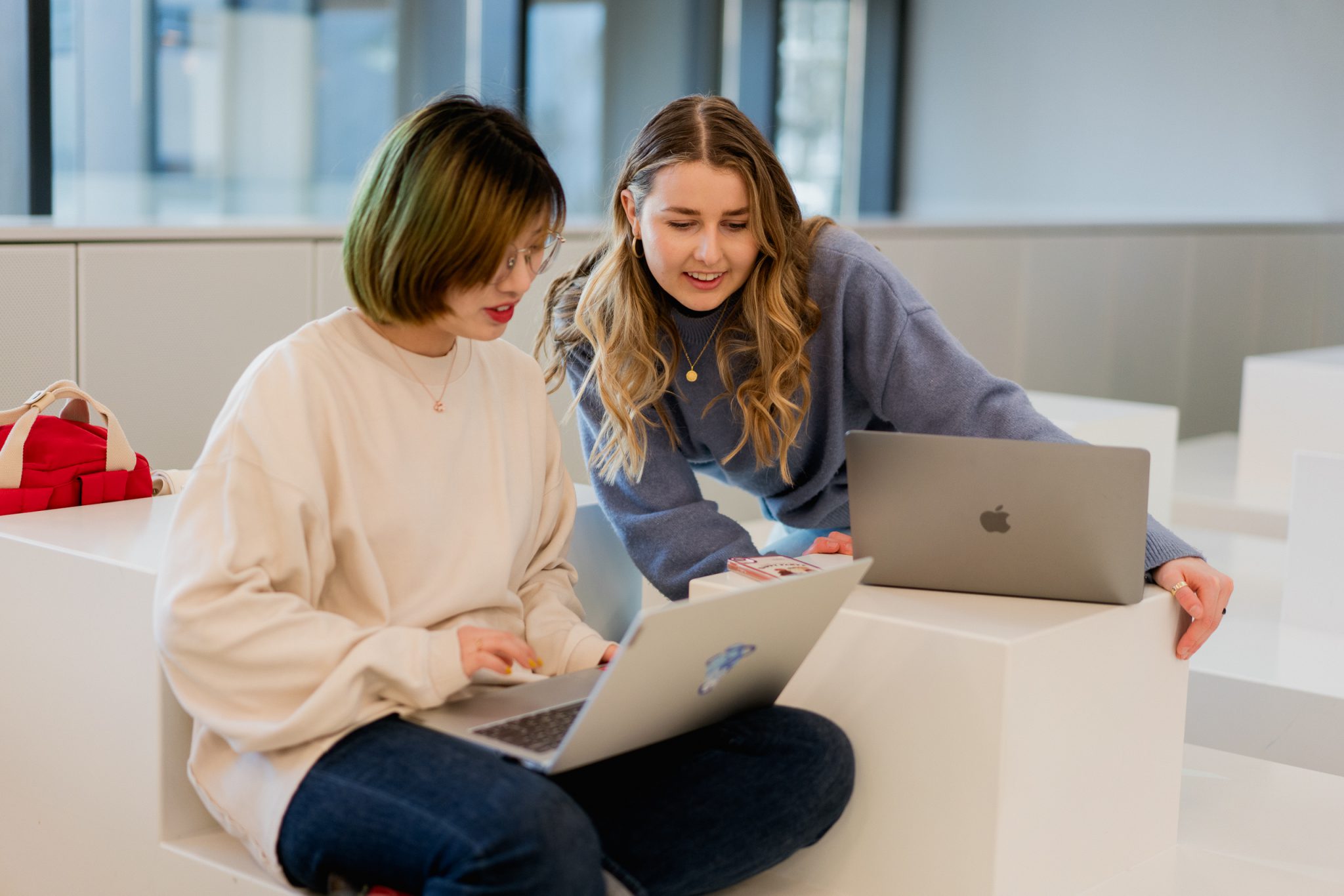
Live grading sessions helped to engage students and improve their learning
Students at the Faculty of Economics and Business pointed out that an online live review and grading session of peer papers was revolutionary and very engaging. Therefore they nominated this practice as a good online practice that they wish to be continued when on campus. Research has shown that learning from peers and their work can be advantageous in online settings (Thomas & Thorpe, 2019). Learning from peers fosters students’ sense of belonging and makes students feel supported, which is especially important to actively promote learning in online settings (Ng, 2019). Also, examples from peers may better align with students’ learning process than textbook examples.
Experience from lecturer Ali Ahmed
Ali Ahmed, junior Lecturer department of Political Science and Faculty of Economics and Business, Academic Tutor PPLE College.
LinkedIn profiel van Ali Ahmed
This is a practice that I would have liked to have when I was a student
This was the first time I taught this course, so I have not taught this course on site. The class was about certain theories. The peer paper reviews were only a small part of my course and took place at the end of the course. I decided to implement these sessions for different reasons, but a starting point was me reflecting on what I would have liked as a student, that maybe I did not get. This is a question I ask myself a lot when I am teaching: what would I have wanted, what would I have needed especially in the first year and I thought it would be nice to give this to the students. I didn’t even know how to structure essays when I first came to university. Nobody told me about a structure, nobody told me about a thesis statement, and it was through very vague implicit forms of feedback that I started to develop as a writer. In my opinion you can do that a lot more explicitly, you can do that a lot more directly, which is one of the reasons why I chose this practice. I think I would have absolutely loved for one of my teachers to do a live grading session with commentary. To see: this is what you did wrong here, so I could really improve my writing.
Live grading session combined with a masterclass in essay writing
Students had to write a paper in the middle of my course and then I asked the class if I could use their papers as an example for ‘public’ review in class. When they gave their consent I asked for volunteers. Even though students said they didn’t mind if it wasn’t done anonymously, just as a safety precaution I removed their names and student numbers. I think this in particular shows how enthusiastic the students were about this practice and I wasn’t even expecting that because a public review can be vulnerable. During the online lesson I opened the paper in Google docs and shared my screen in Zoom and basically did a live marking session on an essay, sentence by sentence, paragraph by paragraph, expressing out loud my thoughts, remarks and arguments. All students had access to the open Google docs document, and my feedback was there to see for everyone even after we ended the session. Furthermore the students themselves could make remarks or questions in the document before and during class. Also I would ask questions in the Google docs document, so the students could prepare their answer for class. So in that sense it also became a master class in essay writing. This live grading session was also about structuring the essay.
My emphasis when I started teaching was that I want students to be able to structure an essay well. To be able to pick up an academic paper and be able to understand the structure and whole flow of the paper. Also the students had to write papers on topics that were difficult to them and the starting point was not the same for everybody. The class consisted of a mix of students coming from different academic backgrounds. Some students were already taught on how to structure their essays whereas for many other students it would be useful to explain those fundamentals, and the prime way to do that is to actually look at the kind of work students are producing themselves.
Peer review as a manner to overcome academic insecurities and keep students engaged
I think there is always much insecurity amongst students, also when I was a student, on how you are doing compared to other students, worrying that maybe your essay is not as good as someone else’s. In an online environment students lack comparison even more, because usually in a regular class on campus you can at least talk to your neighbor, you can look at their works and you can sort of compare, which is more difficult in an online environment. When I was a first year hearing from another student: man I haven’t started this essay or I can’t make sense of this and see someone else’s struggle, this also gave me a bit of reassurance that I wasn’t the only one struggling with it. I thought about how to replicate those real time environments online and decided on this practice to show everyone how everybody else’s essays are and also show them that another student is like you and vice versa.
The benefit of using student examples rather than textbook examples makes it more ‘real’. Students can relate to the quality of the paper, whereas textbook examples are usually too perfect or the mistakes are too obvious. Using peer papers makes students see: I would be able to do this too, it is an approachable thing for me too and maybe that would give students more confidence. The core ingredient of this practice are the facts that these essays are from actual peer students, as well as the walking through a paper, which is more personal. These personal elements really matter to me. Also since it is just not possible for me or any teacher to go into that much depth with 50 or 60 students with the feedback I can give on canvas.
This live grading session is the most personal way possible for everyone to see at the same time the kind of thing that they need to include or not include in their paper. And I also wanted students to interact more because with this digital online environment it is very easy to just disconnect, which I feel can happen after 30 minutes already in an online session. These peer reviews kept the students on board so it was a combination of those things that lead me to implement this practice and based on the feedback I got, it was appreciated and I am glad to hear from students it made writing more accessible. Precisely because of the online situation I came up with this idea, so that is a positive consequence of a not so positive situation. Maybe I would never have thought of this in a physical environment.
A huge success to be continued
I didn’t expect there to be that much engagement, that this would resonate so much with the students. I did not expect students to consent to sharing their papers for review and even be willing to include their names and student numbers, even though I didn’t include those. When I heard students nominated this practice as a good online practice I was so surprised. If somebody would ask me: name some of your practices that would make good teaching, I wouldn’t even list this. I would have listed: being empathetic, being in students’ shoes, understanding their anxieties and insecurities, listening well and connecting with them as a human being, that is really important and also letting students guide the lessons that is really important, letting them be the decision makers as well. These are the ingredients of good teaching and these are the ingredients that led to this practice in the first place. But maybe these ingredients are part of this practice. Apparently students want to keep this practice in the future.
When courses go back on campus, I see this practice either online again, or in a computer lab where students have their headphones on and they see their screen in front of them and then I am talking to them in their headphones. Using Google docs probably worked better than face-to- face, because everyone could easily read along on their own computer and everyone was able to use the comment function, thus creating an interactive setting. If we would do it in a normal classroom with a big screen it would be a lot more difficult, because not everyone is able to read the screen. They will probably get distracted more easily, whereas online it is just very much in your face, the essay itself and the comments, so I would probably implement this digitally in a computer lab. I am really excited about the future, to see how education is affected by this period of online teaching and I think the future lies in a blended hybrid form of teaching.
Tip from Ali:
“Listening to teachers is important, but listening to students themselves and what they want is important too. Listen to students, approach them and do in-depth interviews with them, to find out what it is that they mean and what it is that worked for them and what didn’t work for them. The main mechanism through which we get feedback from courses, I think is through the UvA Q evaluation form at the end of the course, but I feel – and I hear this from students as well – that the evaluation form is not enough. We have to try to really involve students not just at the end of the course, but during the course and take into consideration what they need, so you can adjust your teaching accordingly.”
Student experience
 |
Student Kristupas Radzvila
BA Business administration |
Through these live review sessions we got a deep insight into how we can improve our writing
It was towards the end of the course that the teacher asked if he could use our papers as an example to our peer students. I consented and he shared my paper on the screen in Zoom. Together with Ali, we went sentence by sentence and he pointed out, what is wrong, what is right, the way it should be and the way you can make it better. A world opened up to me, and I found that so very helpful because we never had an opportunity before to see what we were doing wrong or how we can improve our papers using a real, natural example written by one of the students. Since teachers usually have a lot of papers to grade, most of the time the feedback provided on Canvas is very short and not so informative.
Live grading session provided an invaluable opportunity to get a deep insight into how we can improve our writing. Ali explained it in a practical manner, giving us practical tools that we can use in the future. For example, the way he explained how to structure the paragraph by using the ‘Statement, Evidence, Explanation’ method was very helpful: provide a statement, provide evidence for that statement and then explain it. No teacher ever took us, students, by the hand and walked through our papers step by step. Giving insight into their thought process and showing how one can improve their writing, giving insight into the way a teacher looks at a paper and grades it. I found that revolutionary and so incredibly helpful that I nominated this as an example of good online practices.
Seeing fellow students papers was like a reality check
This live grading session was even more useful because we had very difficult papers to write about the complicated theories that were new to us. We hadn’t written anything like that before and we were struggling, therefore these sessions came right in time. Even though Ali erased the names and students’ numbers off the papers, the students involved were absolutely fine with everyone knowing that their paper was being used as an example. I guess they were all so enthusiastic and eager, since on Canvas we don’t get enough feedback, just very vague feedback, not even comments sometimes.
The live grading sessions helped us to see the most common mistakes and how to structure our essays. It gave us a roadmap of what we had to do to get our essays going. And it really helped, since my grades for writing are now on average one point higher than my exam grades. To see an example being graded with the explanation on how to improve it, to get an explanation on what is wrong, what is ok, what is good, that was a brilliant move. It is good that peer papers were used instead of book examples, since you can relate more to that. When you view an essay from somebody in your class it’s a lot more closer to you as a person, as a student. I think this personal element is like a reality check.
Continue this practice preferably online rather than in a classroom
I am the kind of student that likes feedback. Feedback is the way I improve. As much feedback as the teachers can provide I will take it gladly. Give us, students, feedback in any way, shape or form and we will take it in. However, these live grading sessions were such a good practice that I think it should be practiced more and should also be implemented when on campus. It is an underexploited practice and we need to exploit it as the example set by Ali shows that it is unique, good and helpful. I would even prefer these kinds of sessions online than in a live setting on campus with fellow students in a classroom. It’s a personal opinion of course, but I can absorb more in front of my monitor than when I am in the classroom.
It is essential to be able to really take a close look at the paper that is being graded with the screen in front of you, to see and listen to the comments with no distractions lurking around that may cause a loss of focus. When online, you are in a concentration zone with the screenshare, you and the voice of the lecturer. I think in a physical environment you would have more constraints and distractions than when having a zoom session. So in my opinion, these live grading sessions would probably work particularly well online. The world was forced to adapt to a digital environment so now why would you throw away something you have built? Better use it and improve it.
Tip from Kristupas:
“Listen to students and everything will work out. Students want to be heard, not just me. We have social media pages where students express that they want the university to listen to us. I think teachers want to listen to students, but it is probably the University that constrains them because of the way the University is structured. How everything has to be formal in the evaluations doesn’t allow for that specific listening to students. My tip for lecturers would be to implement a live grading sessions like the one was done in this course and to stay awhile after the lecture, whether physical or online, so they can have a real and therefore more fulfilling talk and if students have questions they can ask them.”
Comment from Ali:
“Staying a short while after class is something I started doing as well as classes started progressing. Because at the end of the class I would always say, guys you can send me an email if you have questions, but nobody would say anything. But then later I stayed in the Zoom and once more people had left students were willing to ask more questions. So I will continue doing that when on campus as well. I also provide students the opportunity to set up one on one appointments with me outside of class hours.”
Literature
Thomas, G., & Thorpe, S. (2019). Enhancing the facilitation of online groups in higher education: A review of the literature on face-to-face and online group-facilitation. Interactive Learning Environments, 27(1), 62–71. https://doi.org/10.1080/10494820.2018.1451897
Ng, C. (2019). Shifting the focus from motivated learners to motivating distributed environments: A review of 40 years of published motivation research in Distance Education. Distance Education, 40(4), 469–496. https://doi.org/10.1080/01587919.2019.1681892
This story is part of a series of inspiring practical examples of online education during the COVID-19 pandemic, which emerged during focus group discussions within the research project ‘Online and blended education at the UvA’. This research project provides insight into the experiences of instructors and students with online (aspects of) education and the strategies that instructors have used to stimulate (online) learning.






